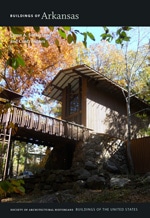Spring Street between the Palace Hotel (CR9) and Rosalie (CR15) winds up the mountainside in a continuous display of Victorian era architecture, from the simplest houses to several of the most flamboyant examples to be seen anywhere. This residence, built for Charles and Eliza Humphrey, who came to Eureka Springs in the early 1880s from Illinois, is the city’s most appealing Queen Anne building. The house resembles Design No. 37 in George F. Barber’s Cottage Souvenir No. 2 (1891). Local builders altered the Barber plan here to accommodate the site, which slopes steeply to the rear. From its asymmetrical floor plan to its exterior elevations, the house embodies the visual dynamism of the style. Particularly recognizable Queen Anne elements are the bold round frame of the forward bay of the front porch, a conspicuous polygonal tower, and the spiky roof. Other George F. Barber designs in Eureka Springs are probable but not documented.
You are here
Charles and Eliza Humphrey House
If SAH Archipedia has been useful to you, please consider supporting it.
SAH Archipedia tells the story of the United States through its buildings, landscapes, and cities. This freely available resource empowers the public with authoritative knowledge that deepens their understanding and appreciation of the built environment. But the Society of Architectural Historians, which created SAH Archipedia with University of Virginia Press, needs your support to maintain the high-caliber research, writing, photography, cartography, editing, design, and programming that make SAH Archipedia a trusted online resource available to all who value the history of place, heritage tourism, and learning.


